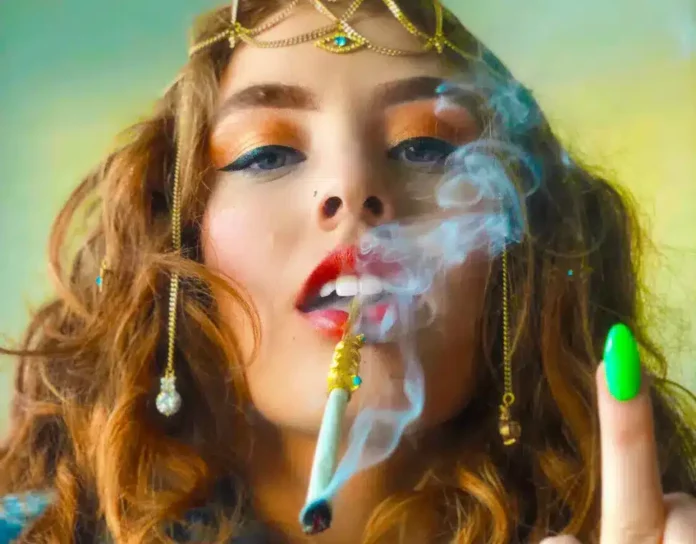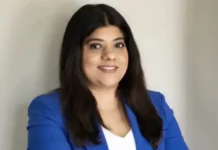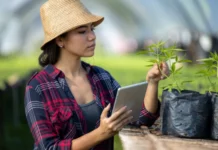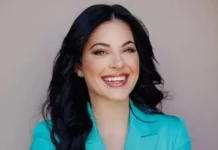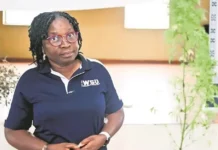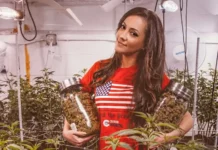Emily Eizen is a queer multimedia artist working in painting, sculpture, photography, modeling and home decor. Her ’60s-psychedelic-inspired works showcase the beauty, freedom and diversity Emily Eizen considers essential to establishing equity in the cannabis space and beyond. Emily’s portfolio and commissions highlight her ability to adapt to different styles and aesthetics across the wide spectrum of gender and sexuality, defying convention. This in-demand artist reflects the colorful and vibrant feelings she experiences while merging the cultures of cannabis and art.
We spent two minutes with Emily Eizen to learn more about her background, creative inspirations and some recent work she’s admired.
Emily Eizen, tell us…
Where you grew up, and where you live now.
I grew up in Manhattan Beach, Calif. I now live in West Hollywood.
How you first got interested in cannabis.
My cannabis journey began when I was in college, freshman year. I was studying political science in D.C., and felt disconnected from my creative roots, and honestly, myself. I started hotboxing the dorm bathroom with my roommate/best friend, and all of a sudden it felt like I found my purpose again. I instantly felt connected to a higher power. I started creating art again, which I had left behind in high school when I really got into activism and politics. Not soon after, I moved back to L.A. and took art classes at Santa Monica College and worked as a budtender. That’s when I noticed a major lack of creative, diverse, meaningful imagery in the cannabis space. I began doing social media for this dispensary, and my career took off.
One of your favorite projects you’ve ever worked on, and why.
The Glass House Farms’ Pride 2022 Campaign titled “Uncon(strain)ed.” This was one of my favorites because it’s the first major shot I got to completely produce a project from start to finish. I was able to hire my friends and LGBTQ creatives in L.A., and work with incredible talent while sending a message of representation and tangible presence in the cannabis industry.
Through my lens, four LGBTQIA+ creatives are transformed into four different Glass House Strains: Wedding Crashers, Lilac Diesel, RUNTZ, Garlic Starship. Using set design, avant-garde makeup and fierce styling, each muse becomes the namesake of a popular cannabis strain. These muses are all real-life cannabis users who incorporate the plant into their respective fields, which range from acting, singing/songwriting and fashion/modeling, to the ballroom scene. By bringing in creatives of all fields, identities, backgrounds and genders, I used my artistry and influence to shift the usual narrative around who cannabis marketing is really for.
A recent project you’re proud of, and why.
Shooting Cheech & Chong for the covers of Leaf Magazines is a recent highlight—Cover #1 and Cover #2. Getting the blessing to not only work with OG cannabis legends, but to be able to influence their “rebirth” as a duo in the modern era is definitely a “pinch-me” moment. It was also an insanely fun and hilarious shoot. Yes, I got to smoke with them!
The biggest challenge cannabis marketers face today, and how to approach it.
The biggest challenges are the legal hurdles companies have to face, combined with strict social media guidelines. Cannabis brands have to have a very limited, implied approach on social media. As the popularity of TikTok grows, many brands have chosen to leave out cannabis in their marketing altogether in order to reach a wider audience through a competitive algorithm. Creatively, this leaves a lot of room to experiment with different modes of expression that relate to cannabis consumers without showing the smoking activity itself. These include art, music and other cannabis-adjacent activities.
One thing about how the cannabis industry is evolving that you’re excited about.
I am excited for the ever-growing number of states that have legalized cannabis. Hopefully this will galvanize federal and state governments to de-schedule and push for thMultimedia Artist Emily Eizen
Someone else’s work, in cannabis or beyond, that you admired lately.
Alana O’Herlihy is a photographer I very much admire lately.
A book, movie, TV show or podcast you recently found inspiring.
We’re Here on HBO made me cry every single episode. It is such an important show, especially with the state of politics right now for the LGBTQ+ and drag communities.
A visual artist or band/musician you admire.
My favorite artists, and one of my many inspirations, is Andy Warhol. We actually have the same birthday, so I feel connected to him especially (big Leo energy). I appreciate the way he embraced more than just one medium during his career. He was an artist, but also cultivated a community at The Factory, which housed and fostered many icons of that time. His colorful use of pop culture is really inspiring to me. Also, artists like Barbara Kruger and Keith Haring definitely inspire my work visually and conceptually. The way they both speak about social issues through their art is something I definitely want to emulate.
Your favorite fictional character.
Jessica Rabbit
Your main strength as a marketer/creative.
Being able to capture the soul of the cannabis industry and create a visual lexicon of true cannabis culture. Adapting to different branded aesthetics while maintaining original creativity and trendsetting motifs.
Your biggest weakness.
As an artist, it’s difficult to not be sensitive about my work. This can be viewed as both a strength and weakness, but sometimes in a professional environment this can cause friction. I’m not afraid to say what I believe and advocate for my work, but learning to have better conversations and not sounding off immediately has been a lesson I’ve taken from those experiences.
Something people would find surprising about you.
I am a huge crossword puzzle nerd. I do the NYT crossword puzzle every day, and I appeared on Wheel of Fortune.
One thing that always makes you happy.
My cat Peggy Sue.
One thing that always makes you sad.
That there have been 452 (and counting) anti LGBTQ bills this year alone.
What you’d be doing if you weren’t in the cannabis industry.
I might be in Washington D.C., making use of my would-have-been political science degree, working for someone like AOC or Bernie Sanders. But that life just wasn’t for me. e release of every person in jail for cannabis charges.

